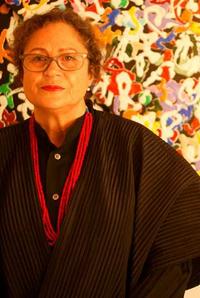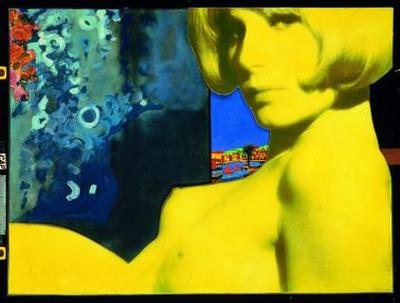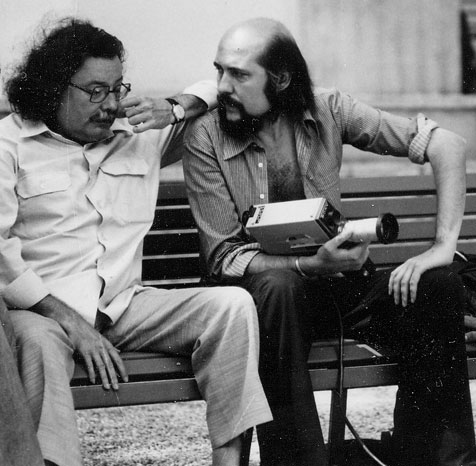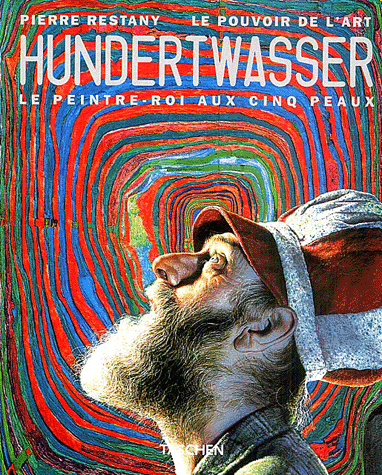
|
In partnership with: 
we present:
La révolution bleue
Yves Klein
Free admission, entrée libre
|
|
|
||||||
|
 |
This program is proposed in French and English. Screenings take place at the Windsor Lecture Theatre, and are followed-on Thursdays only- by a guided tour in french of one of the current AGNS exhibitions.
It is free for all the members of AFH or AGNS
 Autour d'Yves Klein
Autour d'Yves Klein
Rotraut
(src : Steve Meacham) The artist formally known as Rotraut is internationally feted, her paintings and sculptures in galleries as far apart as Paris's Pompidou Centre and Florida's Coral Springs Museum of Art. So you may think it sexist that she is still best known as the widow of Yves Klein, the mercurial French artist who died in 1962, aged 34. Rotraut (pronounced "Roe-trout") isn't worried. As Klein's widow, the mother of the son he never saw, and executor of his estate, it has been her mission to preserve Klein's legacy. Klein - a Judo black belt and student of Zen philosophies - was the European Andy Warhol. Even before they met in 1957 - when she was only 19 - Klein was a celebrity for what would later become known as his "happenings". There was the time he whitewashed an empty gallery and opened it, to acclaim, as "the void". The occasion he strapped a freshly undercoated canvas to his Citroen and sped down the highway so nature could "finish" his handiwork. His penchant for splattering naked women with paint and pressing them against sheets of paper, sometimes in public. And, most famously, his belief that beauty could be distilled into one single synthetic colour which he patented, with typical modesty, as "International Klein Blue". But today, at her home in Bronte, Rotraut Klein-Moquay is talking not about Klein's creativity, but her own. Next Wednesday, Annandale Galleries unveils Rotraut's first Australian exhibition - though she has divided her time between Sydney, Phoenix and Paris since 1998 when she organised a Klein retrospective at the MCA.
 For the past decade she has concentrated primarily on sculpture - large, colourful, plastic pieces brimming with optimism. Yet, she says, for years after Klein's death she found it impossible to paint in colour, particularly blue. "Then, other artists asked if they could use Klein Blue. And I thought, this is silly. I love blue. I used to mix the blue for Yves." The result was one of her landmark "galaxy" paintings, Blue Memory.
Rotraut Uecker was born in 1938 near the Baltic Sea. After Hitler's defeat, the family found themselves in communist East Germany. Rotraut's brother, fellow artist Gunther, fled to the West. When his teenage sister joined him in 1955, their parents were forbidden from seeing her for another decade.
For the past decade she has concentrated primarily on sculpture - large, colourful, plastic pieces brimming with optimism. Yet, she says, for years after Klein's death she found it impossible to paint in colour, particularly blue. "Then, other artists asked if they could use Klein Blue. And I thought, this is silly. I love blue. I used to mix the blue for Yves." The result was one of her landmark "galaxy" paintings, Blue Memory.
Rotraut Uecker was born in 1938 near the Baltic Sea. After Hitler's defeat, the family found themselves in communist East Germany. Rotraut's brother, fellow artist Gunther, fled to the West. When his teenage sister joined him in 1955, their parents were forbidden from seeing her for another decade.
In Dusseldorf, Gunther became "my first art teacher, my father and my mother". Then in 1957 he arranged for her to become the au pair for French artist Armand Fernandez in Nice. One day, when she was alone in the Nice house, a friend of Fernandez called by. It was Klein. Rotraut refused to open the door. She had already fallen in love with his work in Dusseldorf. But she had imagined the artist to be an old, wise, Zen-like figure, "not this young, beautiful man". A few months later they were living together. "Yves was very supportive of my work," she says, but she was also his muse. She was "honoured" when he asked her to strip for his body paintings, "but I only modelled at home, never in public". She was pregnant when they married, but Klein died shortly afterwards of his third heart attack, two months before their son, also called Yves, was born. Only her baby and her determination to continue with the exhibitions Klein had been preparing diverted her from her grief. Then, in 1968 she married Daniel Moquay, father of her other three children. Daughter Lorraine is studying in Sydney. Hers is a long journey: from the Baltic to the Pacific, via Paris and Phoenix. Yet, like Klein, her horizons are unlimited. In Bronte, she says, her favourite subject matter remains "my galaxies ... they make me feel safe". Le Nouveau Réalisme
)
(src wikipedia)
The critic Pierre Restany, who he'd met during his first public exhibition at the Club Solitaire[13], founded the Nouveau Realisme group in Klein's apartment, on 27th October 1960. Founding members were Arman, Francois Dufrêne, Raymond Hains, Yves Klein, Martial Raysse, Daniel Spoerri, Jean Tinguely, and Jacques Villeglé, with Niki de Saint-Phalle, Christo and Deschamps joining later. Normally seen as a French version of Pop Art, the aim of the group was stated as 'New Realism=New Perceptual Approaches To The Real' |
 |
 |
 |
 |
 |
 Autour du film
Autour du film
S/O